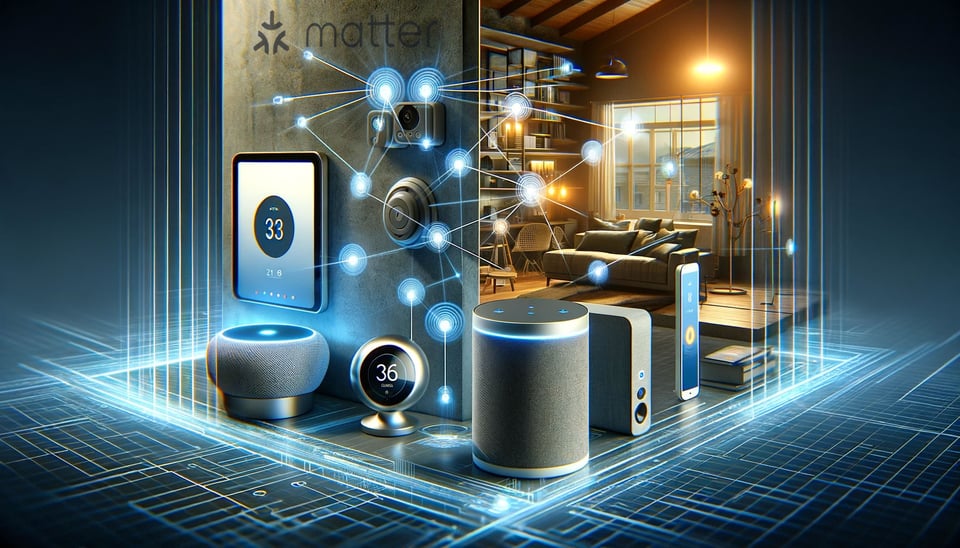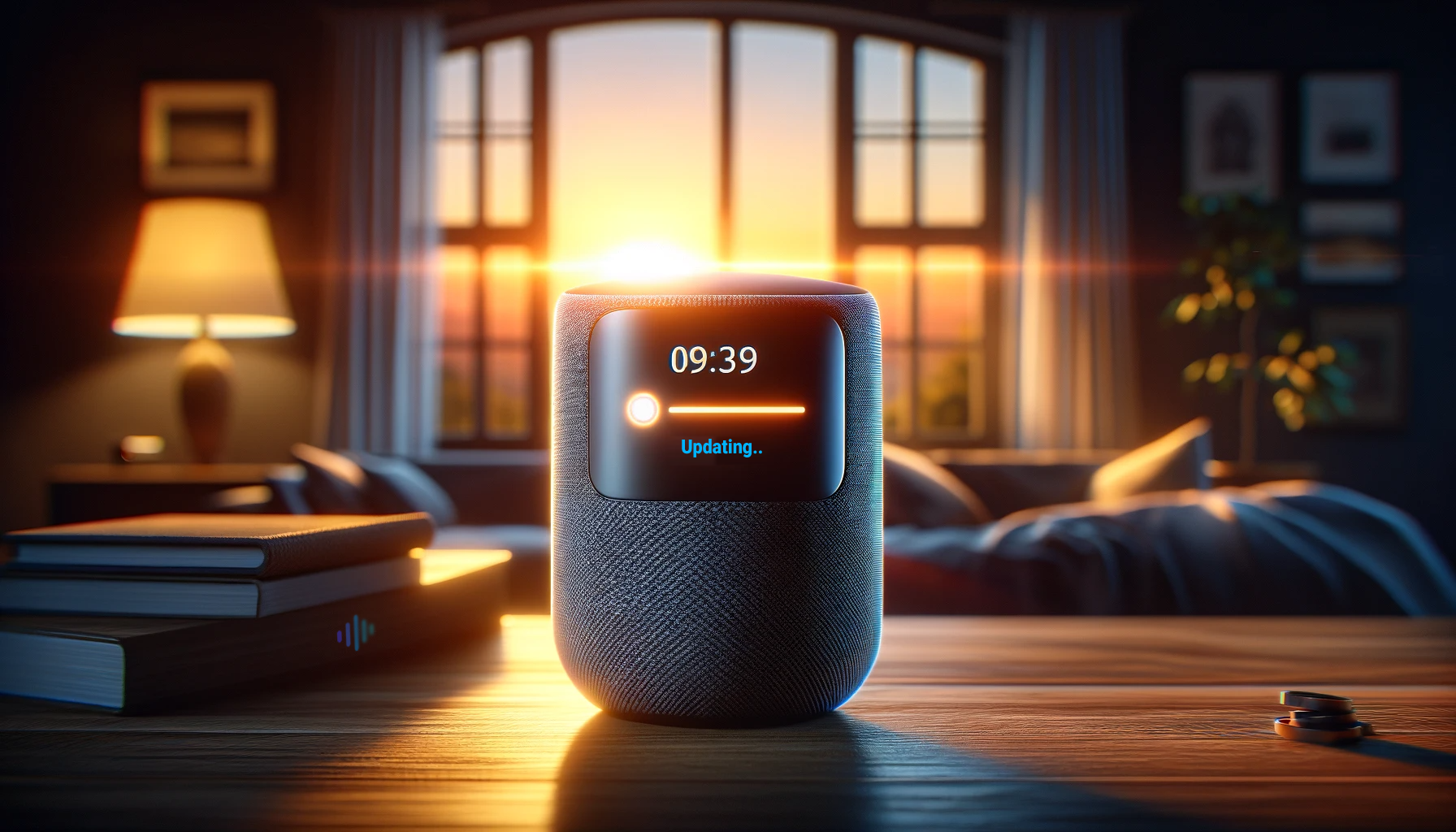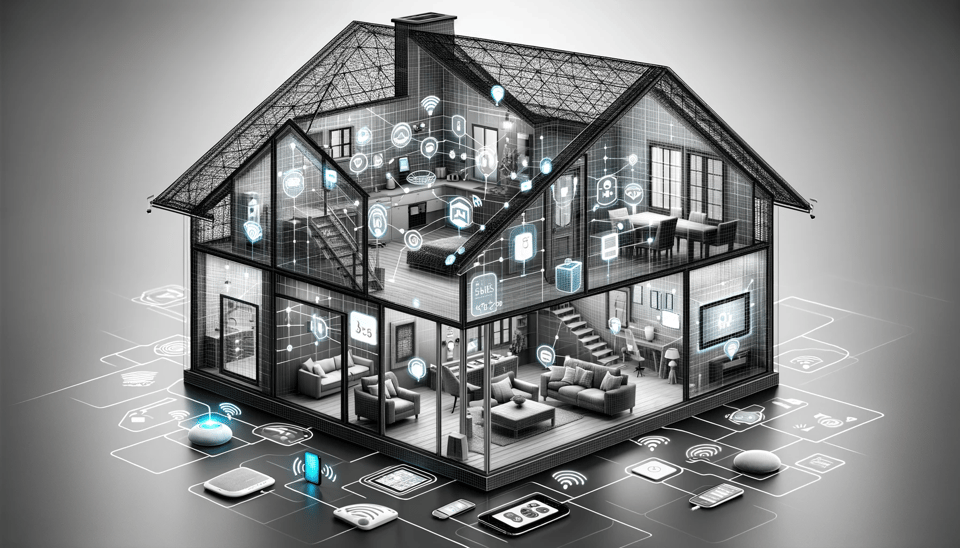Developing with Matter - And why OTA firmware updates are critical.

Developing with Matter and why Automatic OTA Firmware Updates are Critical.
What is the Matter Protocol?
Matter is a protocol designed to simplify the development and deployment of smart home devices, ensuring seamless Matter protocol integration and interoperability across different platforms and brands.
In the field of Internet of Things (IoT) and smart home devices, the Matter protocol emerges as a major innovation. This protocol is designed to streamline the development and deployment of smart home devices, facilitating seamless integration and interoperability across an array of platforms and brands. The protocol enjoys backing from major industry players such as Apple, Google, Amazon, the Bluetooth Special Interest Group (SIG), the Wi-Fi Consortium, and the Zigbee Alliance, heralding a new era of unified smart home ecosystems.
The Evolution of Smart Homes in the Hybrid Work Era
The shift towards hybrid work models has been a driver for transforming homes into sophisticated, intelligent spaces. This transformation is largely driven by the integration of an assortment of smart home devices, encompassing smart light bulbs, speakers, thermostats, video doorbells, and security cameras. These devices are not mere standalone units; rather, they coalesce into intricate ecosystems that substantially elevate the functionality and convenience of our living spaces. Nevertheless, this burgeoning industry is not without its challenges. Notably, there is a discernible trend of various smart home ecosystems operating in tandem, often without full interoperability. Prominent tech giants like Amazon, Apple, Samsung, and Google are vying for market dominance, each aspiring to establish their ecosystem as the ubiquitous choice. This competition, while fostering innovation, also leads to a fragmentation in the market. It creates a landscape where not all devices in a smart home are controllable from a single, unified ecosystem.
Market Growth Amidst Integration Challenges
The smart home device market, as per insights from Counterpoint Research, is on a trajectory of robust growth, with a Compound Annual Growth Rate (CAGR) of 21% projected through 2025. Today's homes are increasingly becoming hubs for a diverse array of smart devices. However, a significant challenge is the integration of these devices into a seamless, interoperable network. Despite the growing affordability of smart devices, configuring them to work in unison remains a formidable task for both consumers and developers alike.
Impact of the Matter Protocol
In this context, the Matter protocol is a significant breakthrough. As an open-source, royalty-free connectivity standard, its aim is to lay down a unified and secure foundation for the future of smart home devices. The protocol enables a harmonious dialogue between devices employing a variety of wireless technologies, including Zigbee, Wi-Fi, Thread, and Bluetooth. Each of these technologies has its unique attributes:
- Zigbee: This low-power wireless communication protocol operates on a mesh network topology. It is adept at enabling devices to communicate with each other and extend the network’s range. Zigbee is particularly effective in powering smart light bulbs, door/window sensors, and smart thermostats.
- Thread: Operating on a mesh network where each device doubles as a router, Thread bolsters overall network coverage and obviates the need for a central hub. It is especially suitable for low-power devices like smart thermostats, sensors, and light bulbs.
- Wi-Fi: Perhaps the most widely recognized wireless technology in smart homes, Wi-Fi offers high-speed internet connectivity. It allows devices to connect to the home network, thereby enabling remote control and monitoring capabilities. Wi-Fi is the technology of choice for devices that necessitate significant data transfer, such as streaming media devices, smart door bells, security cameras, and smart TVs.
- Bluetooth: Originally envisaged as a means to eliminate the clutter created by cables, Bluetooth is now a staple for shorter-range communication. It is ideal for connecting devices within close proximity, typically within the same room, and facilitates seamless streaming and control. Bluetooth is common in most smart home devices including smart speakers, headphones, and mobile devices.
Matter, in essence, functions as a lingua franca, enabling seamless communication between devices, irrespective of their underlying wireless technology. By promoting device compatibility and ease of use, Matter seeks to overcome the fragmentation often associated with smart home devices, aiming to create a more secure, cohesive, and user-friendly smart home experience.

Technical Considerations in IoT Development
When developing IoT or smart products, several key factors must be considered to ensure the product meets functional requirements:
- Communication Range: The communication range is a critical factor determining how far the devices can interact with each other or with a central hub. While Wi-Fi typically offers a broader range, technologies like Zigbee, Bluetooth Mesh, and Thread can employ mesh networking to extend the range. Wi-Fi mesh networking is also gaining a foothold in smart homes and business to provide complete coverage. This is achieved by enabling devices to act as repeaters, potentially allowing broad coverage defined by the number of devices in the mesh network. However, it is important to note that a wider communication range often necessitates more power. Devices supporting higher power modes also tend to support faster data transmission rates.
- Power Consumption: The energy requirements of devices vary significantly based on their functionality. Devices with high power requirements often need to be powered continuously, or if they are battery-operated, they will deplete their energy rapidly and need frequent recharging. Each wireless technology comes with its own power profile, and this must be carefully selected to align with the energy requirements and constraints of the devices. For instance, technologies like Zigbee and Z-Wave are designed to be low-power, making them particularly suitable for battery-operated devices. It is a general rule that lower power devices usually have shorter range and lower data transmission rates.
- Data Rates: Wireless protocols are meticulously designed to strike a balance between power requirements, range, and data rates. Higher data rates typically require higher power or closer proximity, or a combination of these factors. Conversely, networks that prioritise lower power consumption or longer range usually feature lower data rates. The ongoing evolution and updates to wireless standards are predominantly focused on improving this interdependent triad of power, data rate, and range.
- Interoperability: The various different wireless technologies incorporate a high degree of backward compatibility. This feature enables devices from different brands and generations to interoperate seamlessly. However, maintaining backward compatibility can sometimes necessitate reverting to older standards, thereby forfeiting the performance benefits conferred by the latest standards and advancements. Despite this proviso, Wi-Fi and Bluetooth continue to offer a wide spectrum of interoperability for devices. For developers, ensuring compatibility with the Matter protocol is an indispensable aspect of future-proofing their products.
- Data Security: In an age where data security and privacy is paramount, this aspect cannot be overstressed in the context of smart devices. These devices often handle sensitive information and control access to cars, businesses and homes. Therefore, when evaluating and selecting wireless technologies for integration into smart devices, it is imperative to consider the security features and protocols on offer. The Matter protocol is characterised by robust encryption methods and authentication mechanisms, designed to protect data and block unauthorised access.
Developing Robust and Secure Matter-Enabled Smart Home and IoT Products
To guarantee a robust user experience, product developers thoroughly and continuously test their implementations. This testing should verify wireless connectivity and that Matter-enabled devices can communicate and interoperate correctly with other Matter devices. This testing is crucial throughout the development cycle to ensure the product is ready for the market, but testing also needs to continue through market launch and the entire product lifecycle.
Utilising advanced debugging tools and techniques is key to identifying and resolving any issues or errors that may arise during testing. This ensures that the implementation meets the expected standards of functionality and behaviour. Many state-of-the-art automation platforms support control of external lab analysis tools for deep analysis during automated testing. This integration allows for the tight integration of these tools in the product development process. Moreover, it ensures that all logs, traces, and analysis data are collated in a single report, greatly aiding the debugging process.
The testing will encompass a variety of use case scenarios, key user journeys and edge cases to ensure robustness and compliance with the Matter protocol. The multiple permutations inherent in this testing phase can be most effectively managed through the use of test automation in order to manage the range of permutations. This approach enables multiple variables and use cases to be tested continuously throughout the product development cycles. Identifying a robust test automation platform early in the development cycle can avoid the need to rewrite test cases from manual to automated. Furthermore, automated testing ensures that test cycles are always performed to the same specification, and that results are readily available and comparable for assessing market readiness at each milestone. Once developed, these same automated test cases can be adapted for post-launch activities, such as regression testing firmware updates prior to deployment to the end user.

The Vital Importance of Automatic and Robust Firmware Updates
Smart devices and IoT nodes are inherently vulnerable to cyberattacks due to their interconnected nature and the potential security vulnerabilities that can exist even when a system has been thoroughly tested. One of the best-known examples of such vulnerabilities being exploited is the Mirai botnet attacks on IoT and smart home devices. Mirai has been active since 2016, with new variants appearing regularly. As of October 2023, many new Mirai botnet variants have emerged, exploiting a range of smart home and IoT devices. These include wireless routers, Android-based set-top boxes, and Linux-based IoT devices. The botnet conducts widespread Distributed Denial of Service (DDoS) attacks on internet servers and infrastructure.
With Mirai malware and similar threats affecting numerous IoT devices and exploiting both known and newly discovered vulnerabilities, the importance of regular firmware updates to mitigate vulnerabilities is essential for security both of the smart home user and the wider internet. Such updates are also essential to safeguard brand and company reputations and to manage associated remediation costs. Zero-day exploits in IoT and smart connected devices are commonly used to create new attack vectors for Mirai variants. Once these vulnerabilities are exploited, the detection and removal of the malicious code can be challenging. This underscores the necessity of a policy for rapid, automatic updates to firmware. Such updates should occur without requiring user intervention and service, making them more vital than ever.
However, the automatic deployment of firmware updates, alongside the requirements to build and deploy new firmware automatically, introduces another critical need. This need is to ensure that the new firmware is robust and has no regression. A significant incident that highlights the risks involved occurred in May 2023. In this incident, an automatically deployed, flawed firmware update affected a wide range of well-known printers. This led to a large number of printers becoming inoperable, or 'bricked', causing significant reputational damage and financial costs.
This incident of an automated firmware update bricking the product not only highlights the importance of regular firmware updates to mitigate bugs but also emphasizes the need to thoroughly and robustly test these updates before their deployment. The goal is to prevent such costly and damaging errors. Pre-flight automated regression tests for OTA updates before deploying to the end user can greatly mitigate these risks.
The Matter protocol represents a significant advancement in the field of IoT and smart home technology. Its adoption is set to address the pressing challenges of device fragmentation and interoperability, heralding a new era of functionality, security, and user experience in smart home ecosystems. For product developers, understanding and leveraging the potential of the Matter protocol, coupled with rigorous testing and security practices, will be pivotal in shaping the future of this rapidly evolving industry.
Automated End-to-end Testing
Nextgen automation services help enrich the future of smart home and IoT testing, as well as the customer experience, guaranteeing users a seamless integration of technology and comfort.
To find out more about Nextgen's development testing and QA services, please contact Nextgen today on +44 3331 120000.




